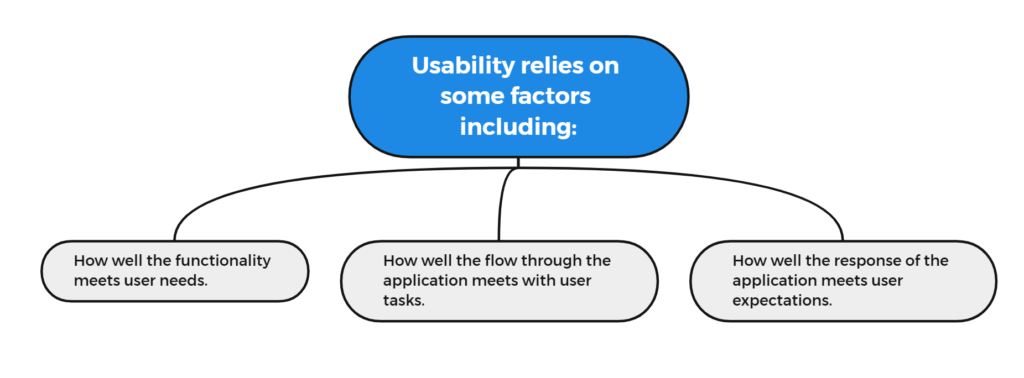
If you have a website or app, you must know the most important success factor is usability. Specifically, how difficult, simple, streamlined, engaging, and intuitive is the user interface (UI) and (UX)?
What is usability?
Usability is a measure of the interaction of user experience associated with a user interface, like a website or software application, a user-friendly interface design is simple-to-learn, supports users’ tasks and goals efficiently and effectively, and is satisfying and engaging to use.
The level of it of an interface may be determined by inviting intended system users to participate in a usability testing session, during a usability test session, a user is given a series of tasks to complete using the system in question without the researcher’s assistance, the researcher observes the user’s activities, emotional reactions, and performance as he attempts to complete each task, the researcher records any moments of confusion or frustration that the user experienced while attempting to complete a task, and also takes notes on whether or not the user was able to satisfactorily complete each task.
The analysis of data from several users allows User Experience Engineers to recommend how and where to redesign the interface to increase its level of usability and, consequently, the overall user experience.
What makes a website or app Usable?
Usability relies on some factors including:
- The functionality that meets user needs.
- How well the flow through the application meets with user tasks.
- How well the response of the application meets user expectations.
We can help you to apply the usability within your website or app when you contact us.

Even the most insightful designer, however, can only build a highly useful system through a process that includes gathering information from individuals who use the system. Usability is the ability of a system that makes it simple to learn, simple to use, simple to remember, fault-tolerant, and subjectively attractive.
What Is the Importance of Usability?
It is crucial from the user’s perspective since it can mean the difference between completing a task correctly or not, and enjoying the process or becoming bored, from the perspective of a developer, it is critical since it might mean the difference between a system’s success or failure, from a management point of view, software with poor usability can decrease the productivity of the workforce to a level of performance worse than without the system.
In all cases, a lack of usability costs time and effort and has a significant impact on a system’s success or failure. When given the option for customers, they choose to purchase a more user-friendly system.
How do you achieve a high usability level?
Iterative design, which refines the design progressively thorough assessment from the early phases of design, is a critical factor for optimizing usability, the assessment processes allow designers and developers to incorporate user and client feedback until the system’s usability is satisfactory., actual user testing on a functional system is the ideal way for assuring usability, achieving a high level of it requires focusing design efforts on the system’s intended end-user.
There are several approaches for determining who the primary users are, how they behave, and what are the activities they must complete. However, clients’ schedules and budgets can sometimes prevent these ideal approaches. Alternative methods include user testing on system prototypes, expert usability audits, and cognitive modeling.
We can help you to have high level of usability when you contact us.
Where is Usability Used?
Human Factors Psychology and Human-Computer Interaction both have a focus on usability. it appears as a bridge that covers the gap between people and machines.
A user interface (or human-computer interface) is a component of a hardware and/or software system that allows a person to interact with it, this covers both output devices (the way the computer communicates with the user) and input devices (the way a user talks to the computer).
Computer displays and the operating systems that run on them are examples of “output devices,” and also include speakers and other devices that offer feedback. “Input devices” include keyboards, mice, and joysticks, as well as microphones and eye movement devices, each of these interface components contains devices that correspond to the brain’s visual (seeing), auditory (sound), and haptic (touch) channels. Usability engineering is the study of these elements of the user’s experience.
Three primary factors for Usability best practices.

Consistency
When someone visits a page or uses a specific sort of device or service, they must become oriented; figure things out, and think things through, so, after you’ve taught people how to use your user interface, stick with it. Maintain consistency. People don’t have to figure it out page by page, section by section. Once you’ve set a standard or protocol, stick to that standard or protocol. Maintain consistency.
Proximity
Put related items together. Related things should be grouped, similar things should be grouped, while different items should be separated, when it comes to UI, group similar items together when you arrange your screen.
Clickability
It is critical to make it clear to users when something is clickable or not, especially when it comes to UI/UX, when concentrating on usability, there are several factors to consider. Quality assurance is one as an example, Usability professionals give close attention to usability while designing a website. It is critical to teach content managers the fundamental ideas and best practices of usability, as well as to perform regular quality assurance.
References:
related posts: